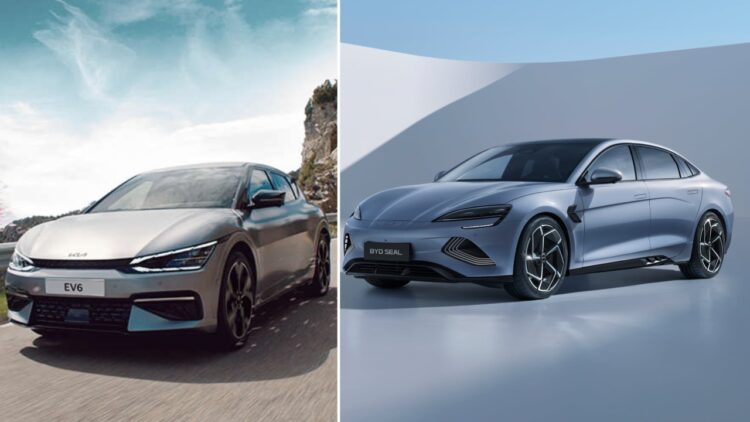The BYD Seal is about to launch in our market as we compare it with the Kia EV6. BYD is getting ready to release its third electric vehicle in India on March 5, 2024. Called the Seal, it’s built on the e-Platform 3.0. Its exterior design takes cues from BYD’s Ocean X series. Internationally, it competes with the famous Tesla Model 3. Besides the Seal, BYD also sells the Atto 3 and e6 electric MPVs in India. On the other hand, the Kia EV6 has achieved immense success in our market with the first batching selling out like hotcakes. Let us compare the two in this post.
You may also like: Expert Reviews India-Bound Kia EV9 3-Row Electric SUV
BYD Seal vs Kia EV6 – Specs Comparison
BYD Seal
For the Indian market, the Seal will come with a dual-motor setup and a choice of two battery packs: either a 61.4 kWh or an 82.5 kWh. The smaller battery gives a range of 550 km, while the larger one can take the EV up to 700 km (CLTC) on a single charge. The smaller battery charges with a 110 kW DC fast charger, while the larger one can use a 150 kW DC fast charger. Together, they produce a powerful 523 hp, allowing the car to accelerate from 0 to 100 km/h in just 3.8 seconds. It boasts a full 5-star Euro NCAP safety rating. Its dimensions are 4,800 mm in length, 1,875 mm in width, and 1,460 mm in height.
You may also like: 5 Electric Cars To Watch Out For in India – Tata Harrier.EV to Skoda Enyaq
Kia EV6
The Kia EV6 comes with a 77.4 kWh Lithium-ion battery available in both RWD and AWD versions. In the RWD setup, it generates 229 PS and 350 Nm of torque. In the AWD version, it produces a higher power of 325 PS and torque of 605 Nm. With 350 kW DC fast charging, it can charge from 10% to 80% in just 18 minutes. It accelerates from 0-100 km/h in 5.2 seconds. The WLTP range is an impressive 528 km. It’s built on the Hyundai Group’s E-GMP (Electric Global Modular Platform), the same platform used for the Hyundai IONIQ 5.
| Specs | BYD Seal | Kia EV6 |
| Battery | 61.4 kWh or 82.5 kWh | 77.4 kWh |
| Power | 523 hp | 229 PS / 325 PS |
| Range | 700 km (CLTC) | 528 km (ARAI) |
| Charging | 150 kW DC | 350 kW DC |
| Length | 4,800 mm | 4,695 mm |
| Width | 1,875 mm | 1,890 mm |
| Height | 1,460 mm | 1,570 mm |
| Platform | e-Platform | E-GMP |
You may also like: Ashneer Grover Trolls BYD Atto 3 with Tesla Badge
Features Comparison
These EVs come with the latest tech and convenience amenities to pamper their customers. BYD Seal is not launched yet. But we know that it could have all the functionalities which it offers in other international markets. These include soft-touch materials, a 15.6-inch rotating touchscreen infotainment display, a 10.25-inch digital driver’s instrument cluster, head-up display, two wireless charging pads, ADAS functions and much more. On the other hand, Kia EV6 has a 12.3-inch curved touchscreen navigation, Augmented Reality Head-up Display, Reclining Front Seats with Zero-Gravity position, electric sunroof, sustainable materials for the upholstery and cabin, digital instrument cluster, connected car tech and more. Both these offer top-notch functions to the users.
You may also like: BYD Seal vs Hyundai Ioniq 5 Comparison – Specs, Features, Design
You may also like: Enyaq iV to Become Skoda India’s First Electric Car
Author’s Note
This comparison is quite intriguing. The electric vehicle segment has been growing in popularity in our market for a while. However, we can only make a well-informed decision once we have all the details about the BYD Seal. We’ll update this section once we have that information.



